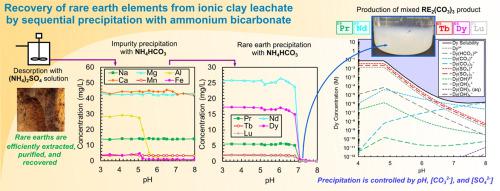Hydrometallurgy ( IF 4.8 ) Pub Date : 2022-07-31 , DOI: 10.1016/j.hydromet.2022.105946 John Anawati , Gisele Azimi

|
Ionic clays, formed by natural weathering of rare earth element (REE)-containing minerals and surface adsorption of liberated ions, are a critical REE resource. Here, the sequential precipitation of impurities and REEs from the desorption of a South American ionic clay is investigated. Selective sequential precipitation profiles are constructed by stepwise addition of 1.3 M ammonium bicarbonate to the lixivium. During sequential precipitation, ammonium bicarbonate first behaves as a pH adjustor to remove co-extracted impurities as hydroxides, and then behaves as both a carbonate ion source and a pH adjustor to precipitate the REEs as carbonates. Impurity precipitation is completed at pH 6.0 and REE precipitation is completed at pH 6–7.5; however, total carbonate concentration during the impurity precipitation step must be kept low to prevent REE loss. To gain a better understanding of the REE precipitation step, thermodynamic calculations using the Davis model are performed. Dysprosium is studied as a model REE and its speciation diagram as a function of pH and total carbonate and sulfate ion concentrations is constructed. It is found that the primary factors controlling REE precipitation are pH, carbonate, and sulfate concentrations. The knowledge gained in this work provides a deeper understanding of the sequential impurity and REE precipitation processes from the desorption lixivium of a unique ionic clay from South America. The results would help guide future work on REE separation from this distinct ionic clay.
中文翻译:

连续沉淀法从南美离子粘土浸出液中分离稀土元素
离子粘土是由含稀土元素(REE)矿物的自然风化和释放离子的表面吸附形成的,是一种重要的稀土资源。在这里,研究了从南美离子粘土的解吸中顺序沉淀的杂质和 REE。通过向浸洗液中逐步添加 1.3 M 碳酸氢铵来构建选择性连续沉淀曲线。在连续沉淀过程中,碳酸氢铵首先充当 pH 调节剂以去除作为氢氧化物的共萃取杂质,然后充当碳酸根离子源和 pH 调节剂以将 REE 沉淀为碳酸盐。在 pH 6.0 时完成杂质沉淀,在 pH 6–7.5 时完成 REE 沉淀;然而,杂质沉淀步骤中的总碳酸盐浓度必须保持在较低水平,以防止 REE 损失。为了更好地理解 REE 沉淀步骤,使用戴维斯模型进行热力学计算。镝作为 REE 模型进行了研究,并构建了其作为 pH 值和总碳酸根和硫酸根离子浓度的函数的形态图。研究发现,控制 REE 沉淀的主要因素是 pH 值、碳酸盐和硫酸盐浓度。在这项工作中获得的知识提供了对来自南美独特离子粘土的解吸浸出液的顺序杂质和 REE 沉淀过程的更深入理解。该结果将有助于指导未来从这种独特的离子粘土中分离 REE 的工作。使用戴维斯模型进行热力学计算。镝作为 REE 模型进行了研究,并构建了其作为 pH 值和总碳酸根和硫酸根离子浓度的函数的形态图。研究发现,控制 REE 沉淀的主要因素是 pH 值、碳酸盐和硫酸盐浓度。在这项工作中获得的知识提供了对来自南美独特离子粘土的解吸浸出液的顺序杂质和 REE 沉淀过程的更深入理解。该结果将有助于指导未来从这种独特的离子粘土中分离 REE 的工作。使用戴维斯模型进行热力学计算。镝作为 REE 模型进行了研究,并构建了其作为 pH 值和总碳酸根和硫酸根离子浓度的函数的形态图。研究发现,控制 REE 沉淀的主要因素是 pH 值、碳酸盐和硫酸盐浓度。在这项工作中获得的知识提供了对来自南美独特离子粘土的解吸浸出液的顺序杂质和 REE 沉淀过程的更深入理解。该结果将有助于指导未来从这种独特的离子粘土中分离 REE 的工作。研究发现,控制 REE 沉淀的主要因素是 pH 值、碳酸盐和硫酸盐浓度。在这项工作中获得的知识提供了对来自南美独特离子粘土的解吸浸出液的顺序杂质和 REE 沉淀过程的更深入理解。该结果将有助于指导未来从这种独特的离子粘土中分离 REE 的工作。研究发现,控制 REE 沉淀的主要因素是 pH 值、碳酸盐和硫酸盐浓度。在这项工作中获得的知识提供了对来自南美独特离子粘土的解吸浸出液的顺序杂质和 REE 沉淀过程的更深入理解。该结果将有助于指导未来从这种独特的离子粘土中分离 REE 的工作。











































 京公网安备 11010802027423号
京公网安备 11010802027423号